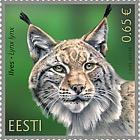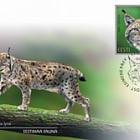2017Estonian Fauna - The Lynx - Set
- 15.09.2017
- Indrek Ilves
- -
- AS Vaba Maa
- Offset
- -
- 40.88 x 41.3 mm
- €0.65
The lynx or the Eurasian lynx (Lynx lynx) is a species belonging to the Felidae family. Lynxes are medium-sized and have long legs; they weigh up to 30 kg. The largest lynx caught in Estonia weighed 40 kg. They are predators whose main prey are roe deer and hares. Their only natural enemy is the wolf. Lynxes have superior hearing thanks to the tufts of fur on their ears, which have an average length of 2 cm (up to 4 cm in the winter). The ear tufts are black and prominent. The fur of lynxes is greyish; their pigment varies from rust-coloured to yellowish and the ends of their tails are black. They prefer to live in out-of-the-way spruce forests which are difficult to access and help them shed their winter coat in the spring. They make their dens into coppices. The lynx usually wakes an hour before dusk and goes out to hunt. If the hunt is successful, the lynx rests until the morning and then goes to hunt again or takes a walk around its premises. Lynxes prefer to always move along the same trails and hunt in certain areas. There are several females living on every male’s territory. Even though each male lynx has several ‘wives’, the father takes part in raising the kittens and teaches, nurtures, and feeds them. Lynxes usually have 1–3 kittens per litter. Newborn lynx kittens weigh 200–300 grams, are blind, and do not have ear tufts. They gain sight when they are 12 days old; ear tufts only become noticeable by the 40th day of their life. Lynx kittens stay with their mother for several years and only separate due to food shortage. The lynx moves elegantly and skilfully even on difficult terrain, trying to catch its prey in just a few decisive leaps. If this does not work, the lynx will not chase its prey. They generally do not follow their prey for more than 20–30 metres. Lynxes can purr like cats, growl, and hiss. Unlike domesticated cats, lynxes like to swim and get in the water even in the winter. Lynxes have several subspecies. Only the Eurasian lynx lives in Estonia; Estonia has one of the most dense populations of Eurasian lynxes in Europe. There are about 1,000 lynxes in Estonia, but very few people are lucky enough to see one in real life. The lynx is the biggest feline in Europe and is under protection.
Estonia - Recommended stamp issues
WOPA+ recommended stamp issues
| Music Giants VII - Iron Maiden |
| Issued: 12.01.2023 |
| ›Great Britain |
| Effigy of H.S.H Prince Albert II - Green Letter Rate |
| Issued: 03.01.2023 |
| ›Monaco |
| Year of the Rabbit |
| Issued: 05.01.2023 |
| ›Guernsey |
| Dimitrie Cantemir, 350th Anniversary of his Birth |
| Issued: 16.01.2023 |
| ›Romania |
| Medicinal Plants |
| Issued: 03.01.2023 |
| ›Romania |
| Honour Guard of the President of the Slovak Republic |
| Issued: 02.01.2023 |
| ›Slovakia |
| Veteran Tractors |
| Issued: 04.01.2023 |
| ›Aland Islands |
| St. Elizabeth’s Church in Parnu |
| Issued: 06.01.2023 |
| ›Estonia |









































